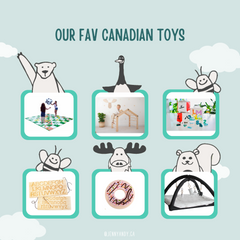On the surface, play may just seem like, well, play - playing and having fun. But play is so much more than simply having fun. Playing actually plays a critical role in a child’s development.
It’s through play that children will learn fundamental skills needed in life - social skills, cognitive skills, and even developing motor skills, to name few.
According to Aistear: the Early Childhood Curriculum Framework’s “Learning and developing through play”, play can have 10 characteristics. Play can be:
- Active
- Adventurous and risky
- Communicative
- Involved
- Meaningful
- Sociable and interactive
- Symbolic
- Therapeutic
- Voluntary
- Enjoyable
1. Active

Play can be active, and during active play, children physically interact with their environment, with different materials, and with others. Active play helps a child develop various kinds of motor skills, the most basic being fine motor skills and gross motor skills.
When children play by manipulating small objects with their hands (think duplo blocks, beading, or picking up small objects), they are strengthening their fine motor skills that can help prepare them for skills like writing and drawing.
Children practice their gross motor skills when they use larger muscle movements, like climbing, jumping, and running.
Mastering these basic motor skills is important for developing more complex abilities like:
- physical strength
- body awareness
- reaction time
- Balance
- Bilateral coordination (the ability to coordinate both sides of the body at the same time in a controlled and organized manner)
- Hand-eye coordination (the ability to move your hands depending on what they eyes see, i.e. cutting paper with scissors)
- Foot-eye coordination (the ability to move your feet in order to respond to what your eyes see i.e. kicking a ball into a soccer net)
- visual motor integration (the ability to interpret visual information and respond with a motor action)
2. Adventurous and Risky

Adventurous play, sometimes called ‘risky play’, can be described as a thrilling and exciting activity that may involve a risk of (minor) physical injury. Examples of adventurous/risky play include climbing tree, going up and down slides, biking, playing chase, and hide and seek. This type of play lends opportunities for exploring new concepts, testing limits, assessing risks, and managing challenging situations.
The benefits of adventurous play includes:
- Promotes independence and problem-solving
- Provides direct experience of cause and effect (natural consequences)
- Develops coordination and bodily control
- Boosts self-confidence and emotional resilience
- Promotes self-regulation
- Reduces stress and fears
- Satisfies natural need for challenge and thrill
The important thing with this type of play is to ensure the right balance between allowing children to engage in adventurous play while preventing serious injuries.
If you struggle with blurting out 'be careful!' every time your child engages in this type of play, try providing more specific and less alarming prompts next time. Some examples that we find work well:
- “Look up” or “Stay low” when there's a chance they could hit their head
- “Stay still” if there’s an unfamiliar animal nearby or if you want them to stop (by saying “Stop,” they likely won’t know exactly what you want them to stop doing)
- “Ouch!” as you point to a stove or hot beverage
3. Communicative

Play presents a natural opportunity for children to share information and knowledge. Children can communicate verbally, using words or their bodies, postures and other non-verbal cues and these messages can be simple or more complicated.
During play, there are natural opportunities for children to exchange knowledge and information. Communication encompasses both verbal and non-verbal communication:
Verbal Communication
As children play, they use verbal communication that will help build their language and vocabulary concepts.
Non-verbal communication
Nonverbal communication plays a significant role in our lives, as it can improve a person’s ability to relate, engage, and establish meaningful interactions in everyday life, and can lead people to develop stronger relationships with others.
Examples of non-verbal communication includes:
- Gestures
- Body movements
- Eye contact
- Facial expressions
4. Involved

As you can see, there is a lot of learning involved in play! It might seem obvious (but can be overlooked in the moment) that for the learning to happen best, children should be involved, engaged, and actively thinking about what they are doing.
Take note that the more motivating an activity is, the more involved your child will be, and the more learning can happen!
5. Meaningful

Play is meaningful and has purpose. It lends wonderful opportunities for children to make sense of the world. Through play, children build upon their knowledge, experiment with new theories, and grow their knowledge and skills.
6. Sociable and interactive

While it is healthy and necessary for children to play independently, at least some of the time, play presents a unique and formative opportunity for children to engage in social interactions and build relationships with other children and adults.
7. Symbolic

Symbolic play (or pretend play) is the ability to use objects, actions, or ideas to represent other objects, actions, or ideas within play and begins to develop between 18-20 months of age. Symbolic play allows children to test out different roles, behaviours, and relationships.
When children engage in symbolic play, they strengthen their:
- Cognitive skills
- Social skills
- Self-esteem
- Language
- Motor skills
- Creativity
Symbolic play may just look like pretending, but it is actually laying the foundation for understanding of themselves and the world outside of themselves as well.
8. Therapeutic

When play is fun, engaging and meaningful, it can be very therapeutic for children. Play can be a natural way for children to relieve stress and work through different emotions and experiences.
Along with many other developmental benefits, sensory play can be especially therapeutic for children to self-regulate and relieve stress. We all have different sensory needs and meeting those needs is important, especially for children and children with special needs and exceptionalities.
9. Voluntary

Play is a self-chosen, spontaneous pursuit that children can change, alter and manipulate freely. Children should and will change the story, characters, materials, events, locations and purpose of their play at will.
10. Enjoyable

Simply put, play is fun! When children play they should be enjoying themselves and they can often find excitement and humour in or through their play. If they aren’t having fun, it probably isn’t play. Instead of playing to win, children should be playing to participate and have fun.
Encourage Play with Jenny and Andy
At Jenny & Andy, we aim to produce creative solutions for real world use by today's family - combining innovative design with sustainably sourced materials that are always safe for baby.
Encourage play, as baby begins to recognize sound and texture, with Jenny and Andy’s Organic Crinkle Toy and Rattle Cube Learning Bundle.


Rattle & Roll Learning Bundle - $35
About the author:
Sam is Jenny & Andy’s Marketing Coordinator. Before she joined Jenny & Andy, she was a speech therapy associate and behaviour therapist who spent 5 years working with young toddlers with autism and other exceptionalities and their families.
Her therapy sessions required her to work collaboratively with Speech-Language Pathologists, Board Certified Behaviour Therapists, Occupational Therapists, Teachers, and Registered Early Childhood Educators.
Sources
Good Therapy
Nonverbal Communication
https://www.goodtherapy.org/blog/psychpedia/nonverbal-communication
Healthline
What Is Symbolic Play and Why Is It Important?https://www.healthline.com/health/childrens-health/symbolic-play#bottom-line
National Council for Curriculum and Assessment
Aistear: The Early Childhood Curriculum Framework, principle and themes (2009)



